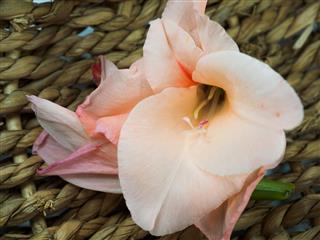
Gladiolus is a flowering plant which produces bright, colorful flowers. The best time to transplant its bulbs is spring. If you have them at home and wish to transplant them, here is an article describing the right method to do it.
Gladiolus, which belongs to the familyIridaceae, is a bulbous plant that produces bright, colorful flowers every year. This perennial plant is also known as sword lily. It is extensively found in Tropical Africa, Asia, South Africa, and Mediterranean Europe.
About Gladiolus
Gladiolus is actually a genus that comprises 260 species, out of which 250 species are native to South Africa and the remaining 10 species are native to Eurasia. Flowers of wild plant are very small in size and the inflorescence bears one flower or more.
Gladiolus plants are grown using corms that are round in shape and are covered with many layers of fibrous tunics that are brownish in color. The leaves of the plant are narrow and sword-shaped and stems produce around 1 to 9 leaves. The bright flowers are found in several colors ranging from pink to reddish, orange to red, white to cream, and light purple with contrasting markings on white.
Corms of gladiolus are not so hardy and need to be removed from the soil during autumn. They are stored in a frost-free place during winters as frost is not good for them. With the arrival of spring, the stored corms are replanted in the soil. Gladiolus is usually propagated using corms or seeds which require a couple of years to begin flowering.
Transplanting Gladiolus
People who have gladiolus at home must have noticed that this plant starts flowering by mid-summer and continues to bloom till frost appears in the winter months. Transplanting involves shifting of a plant from one place to the other. A gladiolus can be transplanted by relocating the corm to a relatively suitable place in a stepwise manner.
Step 1
Identify a place in your garden which receives a lot of sunlight and is well-drained to meet the requirements of the plant.
Step 2
A sufficient amount of mulch in the soil is necessary to keep the weeds away and maintain moisture content in the soil. So, place a layer of mulch on top of the soil where gladiolus will be transplanted.
Step 3
To prepare gladiolus bulbs for transplantation, place the corms in a shallow dish containing water filled up to a quarter-inch of the dish.
Step 4
Keep this dish where adequate filtered sunlight is received. This will trigger the corms to start germinating.
Step 5
When the germinating tip is about 5 inches long, it’s time to transplant the corms in the soil. Dig holes about 8 inches deep and place a corm gently in the hole. Make sure to keep the growing tip upwards to facilitate further growth and cover the corm completely with soil.
Step 6
If the growing tip is less than 5 inches, bury it completely within the soil but take care to cause no harm to the tip. If many corms are to be transplanted, place each of them 5 inches apart so that each one of them gets sufficient area for growth and there is no quest for nutrients and growing space.
Step 7
After all the corms are transplanted, water the area sufficiently so as to maintain a well-drained soil. Regular watering of the corms and adequate sunlight will help the corms to grow into plants capable of producing beautiful, vibrant flowers.
With the arrival of winter, the flowers of gladiolus plant begin to dry out and shed off. If you want to keep the plant in safe custody over the winter months, wait until all the flowers have dried out. With the help of a trowel, dig out the corms from the soil. Remove excess soil from the corms and place them in a paper bag. Secure this bag in a cool and dry place during the winter months, so as to keep the corms safely for re-transplanting during spring. With the arrival of spring, use the method given above to transplant the corms back to the soil so that they can bloom again.
If you want the plant to bloom year after year, it is very important to care for gladiolus plants. Weeds cause a lot of harm to the plant and therefore, removing them regularly will help in maintaining the plant. Regular watering and fertilizing will help in proper growth, and the plant will produce beautiful flowers for many years to come.









